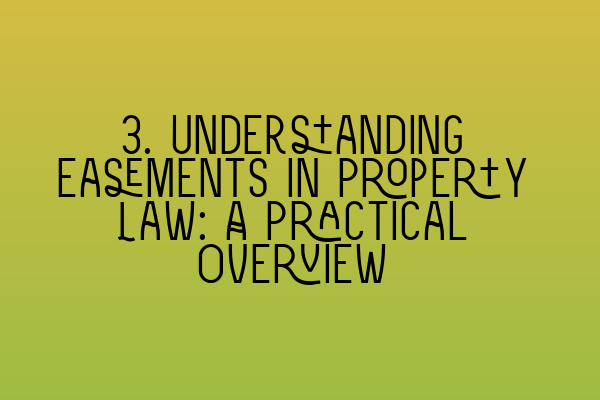Understanding Easements in Property Law: A Practical Overview
Welcome to another informative blog post brought to you by SQE Property Law & Land Law. Today, we delve into the realm of easements in property law and provide you with a practical overview. If you’re studying for the SQE exams or simply interested in expanding your knowledge of property law, this article is a must-read!
What are Easements?
Easements play a crucial role in property law, granting specific rights to individuals or entities over someone else’s property. Simply put, they allow one party to use and enjoy certain aspects of another party’s land without possessing it.
Easements can take various forms, such as the right to pass over a driveway, walk along a specified path, access a water source, or erect and maintain a fence. These rights are often necessary to ensure the efficient use and enjoyment of adjacent properties.
Creating Easements
There are several ways in which easements can be created. The most common methods include:
- Express Grant: A property owner expressly grants an easement to another party, typically through a written agreement or deed.
- Implication: An easement is implied by law based on the circumstances surrounding the property and its use. This is often the case when one property is divided, and the use of certain facilities becomes necessary for the divided parts.
- Prescription: In some instances, if an individual has been using another person’s land openly, continuously, and without interruption for a specified period, they may acquire an easement through prescription or adverse possession.
Understanding the different ways in which easements can be created is essential for both property owners and prospective buyers, as it helps them navigate any potential legal issues that may arise.
Types of Easements
Easements can be classified into several types, each serving a specific purpose. Here are three common types that you should be familiar with:
- Right of Way: This type of easement grants someone the right to pass through or use a specific route or path on another person’s land. It is often seen in situations where property owners need access to public roads or amenities.
- Utility Easement: Utility companies often require easements to install and maintain infrastructure, such as power lines, pipelines, or telephone cables. These easements exist to ensure uninterrupted access and service provision.
- Light and Air Easement: This type of easement protects the right to access natural light and air by preventing adjacent buildings from obstructing these vital resources. It ensures that a property maintains adequate natural illumination and ventilation.
Challenges and Disputes
Like any aspect of property law, easements can give rise to disputes. Common challenges include disagreements over the extent of permitted use, maintenance responsibilities, or the termination of an easement. In such cases, legal advice and expert assistance can help resolve the issues and prevent costly litigation.
If you encounter any easement-related disputes, it’s crucial to consult an experienced property law solicitor who can guide you through the legal process and protect your rights and interests.
Conclusion
Understanding easements in property law is essential for property owners, prospective buyers, and legal professionals alike. This practical overview has provided a glimpse of the various aspects related to easements, their creation, types, and common challenges they can present.
If you’re preparing for the SQE exams, make sure to check out our related articles:
- SQE 1 Practice Exam Questions
- SQE 1 Practice Mocks FLK1 FLK2
- SQE 2 Preparation Courses
- SQE 1 Preparation Courses
- SRA SQE Exam Dates
For any legal assistance or to learn more about property law, don’t hesitate to reach out to SQE Property Law & Land Law. We are here to help and provide expert advice tailored to your specific needs.
